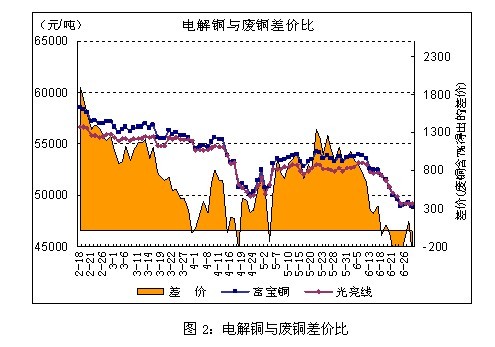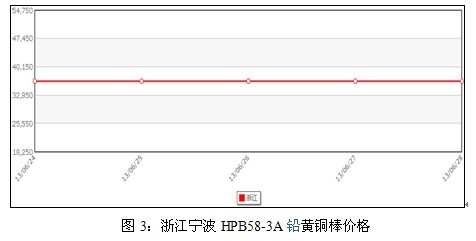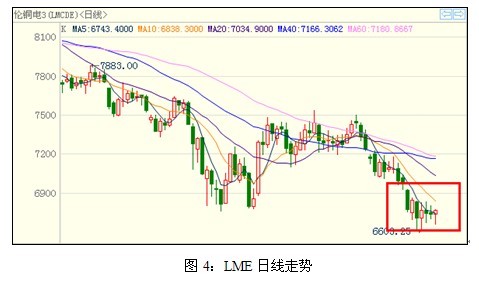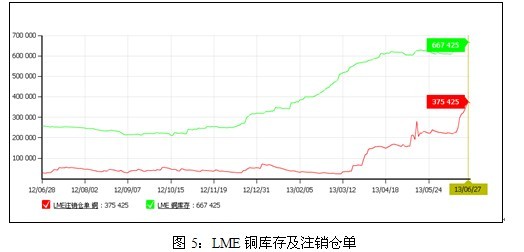Product introduction
Project parameters
Project parameters
The adsorption time of test condition was 58s with an average pressure of 1-2s
Adsorption pressure
Nitrogen purity (%)
Yield (Nm3/ h.t.)
Nitrogen recovery rate
0.8MPa
99.99
80
23
99.9
150
30
99.5
220
36
99
310
42
98
370
45
97
450
47
96
520
50
95
580
55
0.6MPa
99.99
64
24
99.9
110
32
99.5
180
37
99
245
43
98
300
46
97
360
48
96
410
52
95
465
56
Pay attention to Black Strip Molecular Sieve Hhcms-220 Black Strip Molecular Sieve Cms-220,Desiccant Molecular Sieve,Molecular Sieve Bags,Molecular Sieve Continuous Strip Desiccant Zhejiang Changxing Haihua Chemical Co.,Ltd. , http://www.zjcxhhcms.com
First, the electrolytic copper market
After last week's plunge, the copper price trend was relatively stable this week, maintaining a volatile market at the bottom. The spot copper price has not changed much, and the overall fluctuation is less than 1,000 yuan. As for the spot price, the specific data detected this week are as follows: 
This week's spot market bearish sentiment continued, the shortage of bank funds disturbed the attitude of the holding traders, and at the end of the month, the spot traders were very willing to sell goods, and the discounts that were kept wide this week were visible. Different from the futures market, the spot merchants have always preferred to buy and sell without buying. In the face of the current low-cost copper, only the raw material factories that need to maintain normal production are purchased on demand, other businesses continue to stand still; and the middle mover profits The operating space is small and the performance is calm this week. However, the cash flow of the spot holders this week is more obvious, and on the last business day of the second quarter of Friday, many banks closed the system for quarterly settlement. The copper traders have stopped their business and the overall transaction is not satisfactory. If the copper is still under the next cycle, it is expected that the spot transaction in Xiaozhou will be difficult to change. 
In view of the low domestic supply and the partial inventory of the bonded area being locked by the importers and the financing transactions of foreign banks, the recent Yangshan copper premium is still rising strongly and has risen to around US$200/ton. Some traders in the spot market said that it is expected to remain in the future. Will continue to rise, which will also stimulate the current copper price; at the same time, this week, the copper spot discounts continue to decline, and one day, LME copper cancellation warehouse orders jumped 6.6%, the cancellation of warehouse receipts soared, to some extent or It can show that European demand may be better than a while ago. On the whole, it is expected that the copper will remain stronger than the Shanghai copper next week, and the Shanghai-Lennon ratio will rise.
Second, the recycled copper market
1, electrolytic copper and bright lines
From Monday to Friday, scrap copper prices showed a slight decline and then flat. Foshan 1# bright line fell from 46,650 on Monday to 45,950 on Friday, down 700 from last week. The price of electrolytic copper is similar to that of the bright line, compared with last week. Five fell 1150. The price of copper in the first two days was weak. After the last three days, the price of scrap copper was not falling, and the market transactions were in a deserted situation. 
At present, the declaration of scrap copper is still difficult, and the import has not seen any improvement. The spot market is affected by the sharp drop in copper prices. The merchants are reluctant to sell and the goods are aggravated. The domestic scrap copper raw materials are insufficient. The import and reluctance to sell have led to more market supply. tension. The supply shortage itself has a certain boost to the scrap copper price, but the current copper price is weak, the scrap copper price advantage is weakened, and the support is obviously insufficient. Most of the scrap copper processing enterprises are in a state of suspension or semi-stopping, and the market demand has also turned to refined copper processing enterprises, which has caused some domestic copper processing enterprises to stop production and reduce production, and maintain a wait-and-see attitude. Some scrap metal trading markets are very deserted, and the stores are rarely out of business, and there are very few goods for sale. At present, the pressure on the domestic copper market is huge, the inventory is high, and the demand is not strong. The trend of the copper price in the future is difficult to change.
2. The operating rate of copper pipe enterprises in June was 75.8%
Recently, the copper pipe enterprises in the production and operation situation in June were investigated. In June, the average operating rate of copper wire enterprises was 75.8%, which was 2.3% higher than the 74.05% in May. A company reported that: “In fact, 5 and 6 productions are It is almost the same, it is in the peak season, but in July it will definitely reduce production, the peak season has passed, the off-season must reduce production." Comprehensive: the main market is weak overall, corporate orders are not good, business procurement enthusiasm is not high. Copper pipe enterprises have been in a state of price struggle for a long time, and their profit margins are limited. We believe that the late copper consumption is difficult to go strong, if there is a turnaround, it is necessary to wait for the golden nine silver and ten seasons.
Third, the downstream market analysis
This week, Zhejiang Jinlong Hpb58-3 brass rod ex-factory price remained at 36,500 yuan / ton, since the price of copper fell last week, the price of brass rods remained basically stable. Because this week's copper price is in a turbulent tug-of-war, the sideways shock has little effect on the price. The merchants are currently on the sidelines, and the price adjustment is more cautious. 
The overall turnover of the downstream copper market was generally good. Due to the sharp drop in copper prices and the low tide in the peak season, many merchants' orders and output have started to decline in the latter half. According to the research data of the copper pipe enterprises by the Fubao Copper Research Group, the average copper pipe enterprises in June started to work 75.8%, which was basically the same as the orders in May, and the start-up of small and medium-sized enterprises has declined. The merchants report that they will enter the off-season in July and August, and the demand for household appliances such as terminal air conditioners is expected to decline. At the same time, due to the summer temperature factor, the load of the general processing and smelting merchants will decrease, and the production capacity will be reduced. At present, the price of copper has fallen, the space for corporate trade spreads has narrowed, and the cost of raw materials for some copper companies has once again faced upside down. The accumulation of funds for capital has made the company's funds face tight. On the whole, the downstream enterprises have concentrated orders in May and June, and they are basically overcrowded. The large-scale enterprises with fixed channels can still maintain stable construction in July, but the SMEs are affected by terminal demand and price fluctuations, and the order volume is difficult to maintain. .
The current cable companies are also facing a crisis of falling orders. At present, large enterprises are supported by national bidding orders, and they can still maintain high-load operation at the start of construction. However, downstream, there are still many small and medium-sized enterprises; these enterprises still have an advantage in terms of proportion. According to the survey data, cable companies in Anhui, Shandong, Zhejiang and other regions have seen a slight decline in average starts in June, but projects such as infrastructure construction still have a positive effect on driving cable consumption. In the short term, the low price of copper has weakened the profitability of enterprises, and the enthusiasm for production has naturally declined. July is also a low season, and the decline in orders is also reasonable.
Fourth, futures market analysis and forecast
This week, the price of copper fell to the level of 6,600 US dollars, recorded a new low in the past three years, and then rebounded slightly, the decline stabilized, as shown below: 
This week, the global macro focus is on China. At the beginning of the week, inter-bank financial tensions spread to the market, causing a sharp decline in the commodities and stock markets. The Shanghai Composite Index fell to “before liberationâ€; but with the State Council’s signal of maintaining stability and repeatedly emphasizing the fundamentals of market capitalization, The higher interbank lending rate has fallen back to a more stable state. From the attitude of the central bank, it is not difficult to see the state's determination to adjust the structure of the economy. Financial de-leverage is imperative, and the central bank will change the image of the former "nother". In addition, urbanization is gradually showing “spikesâ€. More than 300 billion shantytowns will inject new impetus into economic growth. It is difficult for the country to tolerate economic growth to 7.5% or lower. The government’s ability to control the economy remains biased. Strong. In Europe, economic data shows that the Eurozone economy is gradually improving, especially in countries where Germany is the locomotive; but the impact of the debt crisis still exists, and Italy will face more challenges in the future. In the United States, since Bernanke’s words have been rampant, the dollar has soared, the yield of government bonds has risen sharply, and market panic persists. As the Fed’s explanation of monetary policy gradually eased market worries this week, QE’s exit The economic growth is related and there will be no exact date of withdrawal.
Fundamentally, this week focused on LME copper stocks and cancelled warehouse receipts. As shown below: 
According to data from the International Copper Research Organization (ICSG), the global refined copper market was oversupply by 104,000 tons in March 2013. In March, global copper production was 1.804 million tons and consumption was 1.7 million tons. ICSG said that in the first quarter, the global refined copper market had a surplus of 222,000 tons, compared with a supply shortage of 312,000 tons in the same period of 2012. Data show that in the first three months of 2013, global copper use was 4.966 million tons, a decrease of 5.3% from the first quarter of 2012. In China, copper consumption decreased by 10%, as net imports of refined copper decreased by 46%. China is the world's largest consumer of copper, and its copper demand accounts for about 40% of global demand.
Investment bank's latest forecast: Morgan Stanley expects copper price in 2013 to be US$7,800/ton; 2014 average price forecast: US$7,900/ton. Credit Suisse lowered its 2013 average price forecast for copper from $7,482 per ton to $7,240, and its 2014 average price estimate fell from $6,675 to $6,225. Goldman Sachs announced a new copper price estimate, expecting copper prices to be $7,000, $6,600 and $6,600 per ton for three, six and 12 months, respectively, compared with $7,500 and $8,000 respectively. And $7,000.
From a technical point of view, copper prices are in a long-term decline, and there will be lower prices in the second half of the year; from a short-term perspective, Lun Copper has strong support in the range of $6,500-6,600, and the KDJ indicator has bottomed out. There are signs that the possibility of a short-term downtrend will increase, and next week's copper price trend will be more dependent on China's economic data.
In summary, we are more inclined to stabilize the copper price in the short-term, and it is expected that the possibility of further decline next week is small, but this does not affect our judgment on the long-term weakness of copper prices. Short-term copper support is 6600 US dollars, pressure is 6800 US dollars (more likely to break through), second pressure is 7000 US dollars; corresponding copper price range is 4.75-5 million; spot copper is 4.8-5 million; scrap copper 4.52- 4.72 million.
HHCMS-220 Carbon Molecular Sieve
The HHCMS-220 is a new nonpolar adsorbent designed to extract nitrogen-rich gas from air. It is suitable for separating nitrogen from air. It has a high adsorption capacity for oxygen and can separate nitrogen from air.
The most notable features of the carbon molecular sieve are high gas-producing efficiency and low energy consumption, especially for the preparation of nitrogen with a purity of less than 99.5% to 99.9%.
The diameter of:1.0-1.3 1.3-1.5
Packing density:≥660kg/m³
The intensity of particle:≥95
Compressive strength abrasion:≤1%
The moisture content:≤0.5%
Standard packing:20Kg/barrel. 40Kg/barrel. 130Kg/barrel
1. The nitrogen production equipment can reduce the adsorption temperature to better show its excellent nitrogen production performance under conditions;
2. Pay attention to low temperature drying and seal preservation during storage;
Copper prices are expected to stabilize and remain weak in the long-term
Abstract Core Tip: On the whole, we are more inclined to stabilize the copper price in the short-term, and it is expected that the possibility of further decline next week is small, but this does not affect our judgment on the long-term weakness of copper prices. Short-term copper support is $6,600 and pressure is $6,800.
Core Tip : On the whole, we are more inclined to stabilize the copper price in the short-term, and it is expected that the possibility of further decline next week is small, but this does not affect our judgment on the long-term weakness of copper prices. Short-term copper support is 6600 US dollars, pressure is 6800 US dollars (more likely to break through), second pressure is 7000 US dollars; corresponding copper price range is 4.75-5 million; spot copper is 4.8-5 million; scrap copper 4.52- 4.72 million.